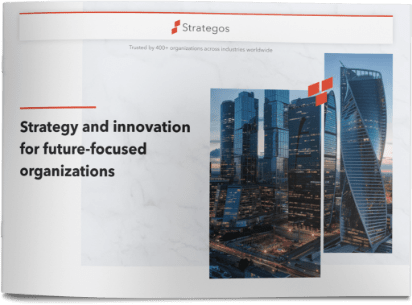“It’s all about the dialogue” is a key tenet at Strategos. Dialogue is how our clients form and flex ideas for innovation. Dialogue is how clients debate and decide what competitive advantage will drive future growth. Dialogue energizes the entire organization. But is your organization really engaging in productive dialogue? We all talk a lot. Yes. We attend far too many meetings. We read and write thousands of emails. But in many organizations, talking and meeting and emailing may exchange information efficiently but they don’t foster dialogue.
Creating a point of view
Many of our clients seek transformational change. Often the first change we effect is a change in communication. Dialogue needs to be open to new concepts and also to conflicting concepts. Those concepts can be a business idea or a way to compete. You can get there by asking different questions or by seeking out different sources. After a wide ranging discussion, dialogue needs to create a point of view. The discussion must create a shared understanding. The organization’s point of view will be the foundation for action.
Diverge before you converge
We structure client discussions to diverge first and then converge. Diverging allows a lot of different and often competing thoughts to be heard. Divergence is open. Everyone loves to voice their opinions and just being heard creates energy and excitement. We encourage clients to involve participants from across the organization and also external partners. Looking at other companies and their approaches also helps to broaden the discussion.
Making choices
Once we have a wide array of clear, compelling concepts, we need to choose which ones are right for us. Converging involves synthesizing and choosing. While we encourage talking about everything, we do not recommend doing everything. Choice is critical. Leadership must make decisions and then support those decisions with resources. The combined discussion of divergence and convergence is what sparks long term enterprise energy and moves ideas into action.
Facilitating dialogue
At its core, dialogue means speaking and listening or reading and writing. There is the ongoing debate about whether texting and posting constitute dialogue. I’m sure the opposing answers of “yes” and “no” are highly correlated with age. Whatever the format, delivery or environment, we exchange thoughts and ideas with words.
Daniel Kahneman’s book “Thinking, Fast and Slow” has a wealth of insight about memory and judging. A couple of points are helpful for anyone attempting to promote open dialogue, frame questions or facilitate discussions.
1. Shaping
Our brains automatically make associations and memories, so immediate surroundings and recent words or pictures will influence your thoughts. There are all kinds of psychological experiments that prove this out. No one likes to admit that this applies personally, but it does. As facilitators,
- Use this to your advantage to set up an open, energetic environment
- Don’t skip the overview or introduction to set context. But choose your words carefully:
“We’re here to decide the next steps for our Project Apollo” will set people into decision-making mode which is fine if that’s what you want to do.
“We’re here to talk more about Project Apollo” will work better if you are trying to elicit input.
- Know what meetings preceded yours and build in time or exercises for people to shift gears
2. Sequencing
Not only is recency important, but so is the order of information. “In an enduring classic of psychology, Solomon Asch presented descriptions of two people and asked for comments on their personality. What do you think of Alan and Ben?
Alan: intelligent – industrious – impulsive – critical – stubborn – envious
Ben: envious – stubborn – critical – impulsive – industrious – intelligent”[1]
As facilitators, structure topics separately to allow full discussion and to build appropriately. Consider the order carefully not only by topic but by the style of your presenters. Generally this means concepts and insights first with details and financials later.
3. Speed
Everyone wants the answer, NOW. A major theme in Kahneman’s book is that the brain is wired for quick decisions even when this means shortcuts in logical judgment. Our digital world feeds the fire on this human tendency. This evolutionary predisposition is a daunting hurdle when trying to facilitate a thoughtful dialogue. The best counter to impatience for a solution is the facilitator’s speed bump: silence. As the facilitator frame up the appropriate question and let the silence continue until someone from the group breaks it. Don’t continuously reframe or try to jump-start the interaction. Someone from the group will break the silence eventually.
If there were quick, straightforward, quantifiable solutions out there, Strategos’ clients would not need us. Guiding a robust dialogue to craft responses to complex situations is what we do with each client to deliver the best results for each of them.
[1] Daniel Kahneman, Thinking Fast and Slow (Farrar, Straus & Giroux, 2011)





